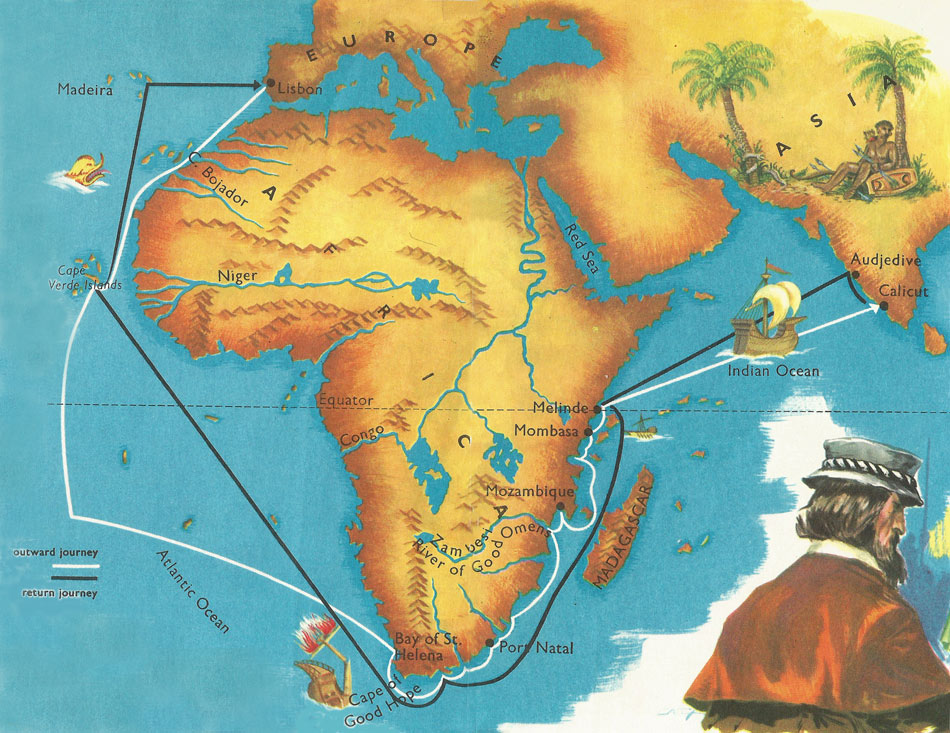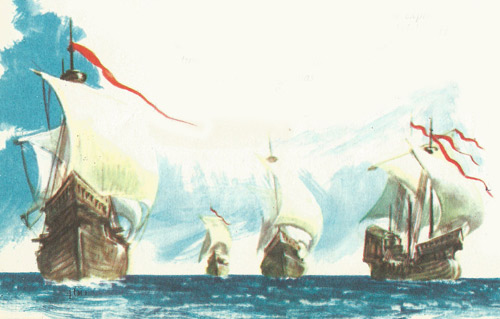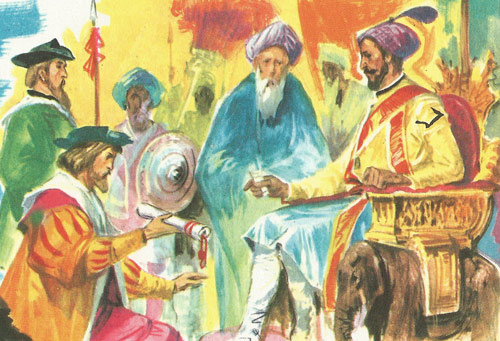Vasco da Gama

A map showing the voyage of Vasco da Gama.

Four ships, called caravels, took part in the expedition. Vasco da Gama commanded the 'San Gabriel.' His brother, Paola da Gama was captain of the 'San Rafael.' The two other ships carried the expedition's provisions. The money for the voyage was provided by the Florentine banking firm of the Serigi, from whom the King of Portugal had borrowed money before.

Vasco da Gama presents to Samudrin the letter given him by the King of Portugal. The letter asks permission for the Portuguese to trade freely in India.
In the fifteenth century very little was known of the geography of our globe. America and Australia were undiscovered and very little had been found out about Asia and Africa. It was not even known that if a ship sailed down the west coast of Africa, it could find a way through to the Indian Ocean, although some geographers at that time had guessed that this might be so.
The journey would certainly be worth making. The riches of what was loosely called 'The Indies' were fabulous, particularly in the matter of spices. It is difficult for us to imagine now how much Europeans at that time felt the need for such things as camphor, pepper, cinnamon, ginger, or nutmeg. We either take these things for granted or, with our methods of feeding cattle in winter or keeping food in refrigerators, get on without them. But for people of those days spices could make all the difference between a diet of salted food and something more interesting.
At that time, the produce of the east was very expensive in Europe, for it arrived after a long journey, mostly over land. The European country which could first reach the Indies by sea and thus monopolise the spice trade would be fortunate indeed. It was the nations of southern Europe which first began to try.
The very first navigators to make an attempt at opening up the route round Africa were the men from Genoa in Italy. But they never returned.
In 1455, a Venetian sailor and a Genoese tried it again. But they got no further than the Cape Verde Islands off the west coast of Africa. There they turned back. The glory of reaching the southern limits of Africa and actually entering the Indian Ocean belonged to a Portuguese – Bartholomew Diaz (c. 1450–1500). He completed his daring voyage in 1482. He met such terrible storms on reaching the southern tip of Africa that he called it the Cape of Storms, but the King of Portugal, thinking that its discovery was like the opening of a door to fabulous riches, changed its name to the Cape of Good Hope. He decided that another expedition must be equipped which should finally reach the Indies. The honor of commanding it was given to a 28 year-old Portuguese – Vasco da Gama.
The voyage of Vasco da Gama
8 July 1497. The ships set sail from the port of Lisbon. Among the 600 men on board was Bartholomew Diaz. The king of Portugal had ordered him to go to Mina, a place in Portuguese Guinea, to direct an important business venture of the Portuguese colony there.
14 July. After rounding the island of Madeira, the caravels sighted Cape Nao and passed by Cape Bojador. Until 1434, when the navigator Gil Eannes succeeded in passing it, this point was called Finis Africae – the limit of Africa. It was believed that beyond it ships were devoured by monsters or destroyed by terrible storms. Portuguese sailors had a proverb which reveals how much they feared that part of the African coast: "He who touches Cap Nao will never return."
16 July. The caravels dropped anchor in a bay in an island of the Cape Verde group. Here Bartholomew Diaz left the expedition to continue his voyage to the Guinea coast. Towards the end of July, Vasco da Gama gave the order to continue the voyage southwards.
Mid October. After weeks of sailing the ocean, during which the San Gabriel was nearly shattered by a violent storm, the caravels crossed the equator. They were thus in the southern hemisphere, that part where, so wise men had it, a ship would surely fall into the abyss.
Early November. 'Land! Land!' shouted the lookouts. After over 4,000 miles of ocean, the cry brought frenzied joy. Vasco da Gama gave the order to disembark in a bay to which he gave the name Saint Helena. After a few days the expedition sailed on.
20 November. The southernmost point of Africa was reached. The lookouts caught sight of the Cape of Good Hope. According to an ancient legend, the great rock of this cape was inhabited by the Giant Adamastor, the spirit of storms. It was said that on whoever ventured near his abode Adamastor unleashed violent tempests. But who could believe such legends after the voyage of Bartholomew Diaz? Fearlessly, Vasco da Gama ordered his ships to sail round the dreaded cape. At last, the 'Sea of the Indies', the Indian Ocean, was before him.
Christmas 1497. Having sailed along the eastern coast of the continent, the caravels dropped anchor in a bay. Because it was the feast of the Nativity, Vasco da Gama called the spot 'Port Natal'.
7 January 1498. Still sailing along the coast, the caravels sighted a river, whose waters were crowded with the ships of the inhabitants. Vasco da Gama discovered that the people were the 'Kaffirs' of the powerful kingdom of Monomatopa. The king's name was Monoemug. Since the people were so friendly to the voyagers Vasco da Gama called the region 'The Land of Good People'.
Mid February. The fleet reached the mouth of the River Zambesi and dropped anchor. Vasco da Gama found that the Arabs came there to trade. The inhabitants had heard of the Indies. Delighted at the news he called the river 'The River of Good Omens'.
14 April. After a short stay at Mozambique the fleet reached Mombasa. The reason Vasco da Gama was still hugging the coast of Africa instead of making off to the East in the direction of the Indies was because, as well as trying to find the route to the Indies, he had the job of trying to plot the outline of Africa on a map. We have his notes, and from them a map of Africa could be drawn which would be remarkably accurate.
20 May. In early May the fleet had set sail from the port of Melinde in East Africa, and at dawn on the 20th they dropped anchor at Calicut on the coast of Malabar. So after ten months' sailing the great goal was reached. The sea route to the Indies was discovered.
India in those days was divided into a number of small states. Malabar was one of them. The Emperor of Malabar was called Samudrin – the Lord of the Sea. The port of Calicut was then one of the centers of eastern trade. Arab, Algerian, Tunisian, and Jewish merchants went there with their ships to load the produce of the East and take it, via Egypt, to the Mediterranean. Vasco da Gama got Samudrin's permission to trade in India. But the Arab merchants were afraid these newcomers would take trade from them. They raised the local population and forced the Portuguese to leave. Vasco da Gama set out on his return journey on October 5, 1498. In September 1499 he reached Lisbon to a triumphant reception. The King made him a Count and Admiral of the Fleet. On Vasco da Gama's tomb can be found the following words:
HERE LIES THE GREAT NAVIGATOR DON VASCO DA GAMA COUNT OF VIDIGUEIRA, ADMIRAL AND FAMOUS DISCOVERER OF THE EAST INDIES.
